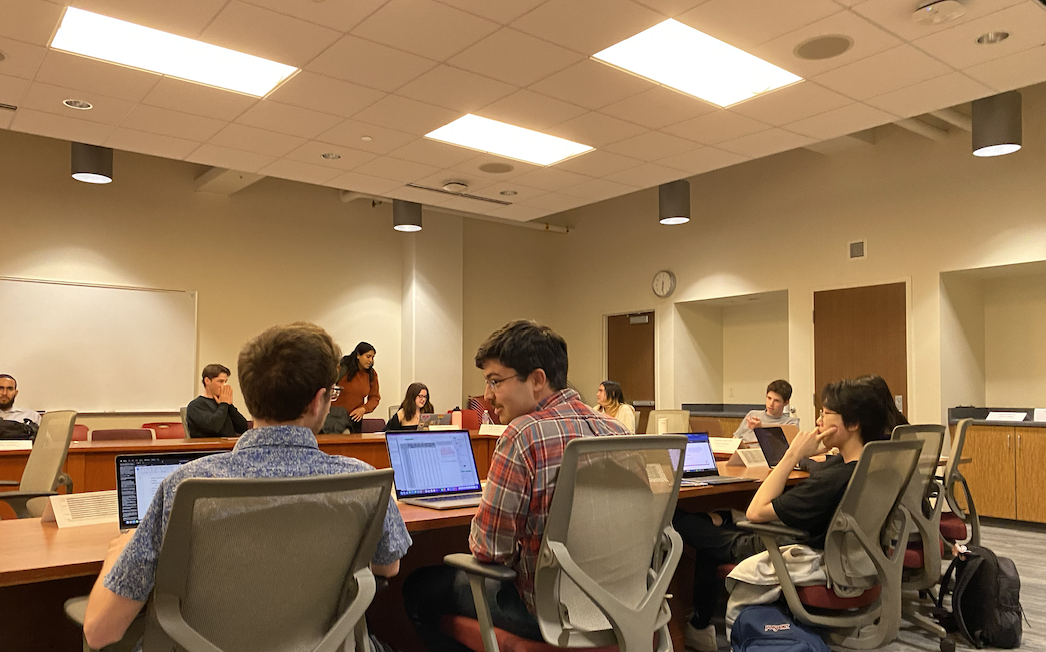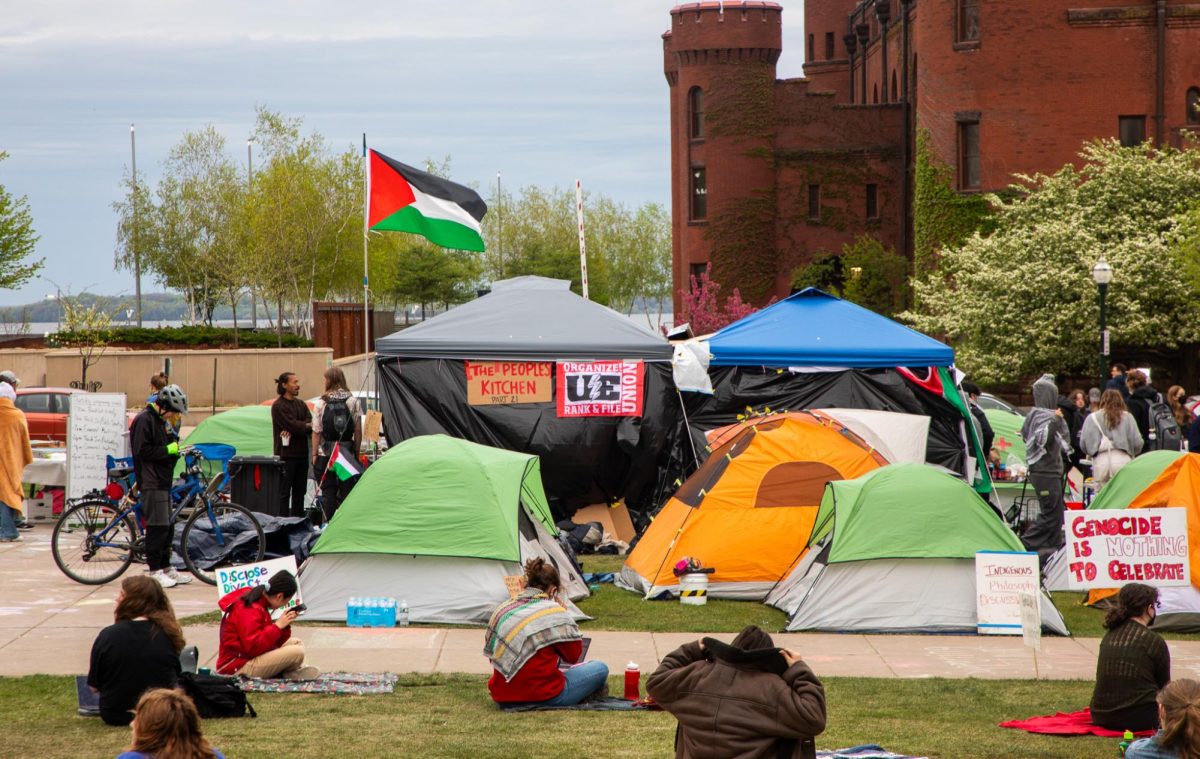Celebrating the 35th anniversary of the Multicultural Student Center has been a goal for Claudia Guzmán since she was hired as director of the MSC in 2020.
“I see the MSC as a respite or a place where you can feel safe, relax and be your authentic self,” Guzmán said. “But as a result of that, you also feel affirmed, strengthened, cared for and loved in a way that lets you go back out into spaces where you’re underrepresented and marginalized and still feel confident in your sense of agency and belonging.”
Located in the Red Gym, the MSC includes nine staff members and four identity centers — the Asian Pacific Islander Desi Student Center, the Black Cultural Center, the Indigenous Student Center and the Latinx Cultural Center — with plans of expansion to further support underrepresented groups on campus. In particular, recent efforts have been made to support Middle East North African students on campus.
Guzmán, MSC 35th Anniversary Historical Intern Maggie Konig and others at the MSC are organizing two events to celebrate the 35th anniversary — an anniversary gala and a historical exhibit and art gallery.
The MSC 35th Anniversary Gala will feature display boards about the four identity centers and a keynote address by Candace McDowell, the founding director of the MSC from 1988 to 2010 — the longest tenure of any MSC director.
The gala will also be the launch of the MSC’s 2024 fundraising and alumni engagement initiatives. The MSC started an alumni newsletter in the fall to generate contact information for people who would consider themselves MSC alumni in order to include them in the upcoming 40th anniversary celebrations.
The “Exist, Resist, Persist: 35 Years of the MSC” exhibit and gallery was created in partnership with the Rebecca M. Blank Center for Campus History. Along with original artwork, the exhibit will include historical panels about MSC’s 35 years. The MSC called for art from faculty, staff, students and alumni who have a piece of art that represents the impact the MSC had on them.
“The history is very objective, whereas the artwork will be more subjective and tell personal stories,” Guzmán said.
The MSC has hosted similar events during APIDA and Latinx Heritage Months, and Guzmán said the mix of subjective art and objective history makes for a successful event.
Guzmán said working closely with the Rebecca M. Blank Center for Campus History has helped provide a comprehensive history of the MSC. But it has also shown there are big gaps in the documented history.
“I feel like this is just the beginning of probably an ongoing project to do a better job of documenting the last 35 and 40 years,” Guzmán said. “The 35th is almost just planting a seed for the 40th. It’s helping us realize what’s missing and what more could we do to ensure the legacy of the MSC and expand it.”
The MSC was established on the University of Wisconsin campus in 1988 at the recommendation of the Ad Hoc Committee on a Multicultural Center. The Committee “recommended the creation of a centrally located Multicultural Center at the UW–Madison, which, at the outset, was to focus on the needs of five targeted American minorities: Afro-American, American Indian, Chicano, Asian American, and Puerto Rican.”
https://badgerherald.com/news/2024/03/05/second-consecutive-mena-heritage-month-uplifts-celebrates-students-across-campus/
Throughout her tenure, Guzmán has watched as the foot traffic ebbed during the COVID-19 pandemic, but now steadily flows.
“Students were so isolated during COVID that they were hungry for community once all those measures were lifted,” Guzmán said. “They’re showing up to things and are more engaged than before, which is great.”
According to Guzmán, the MSC annual foot traffic was approximately 19,000 during the 2018-19 school year. In the 2021-22 school year, when the campus returned to in-person activities post-pandemic, that number rose to 32,841. This year, foot traffic is on track to exceed 50,000. The Indigenous Student Center, located at 215 N. Brooks Street, saw an increase of over 800 last year from the year before.
“These utilization numbers demonstrate how vital the MSC is to the student body, and particularly students of color, who are looking to build community, develop leadership skills, learn, study, socialize and cultivate their own complex and nuanced sense of belonging at UW,” Guzmán said.
But as the MSC grows, Guzmán said more light is shed on the need for more space. The MSC lounge can fit around 90 people, but Identity Center Heritage Months attract closer to 135 students. The APIDA and Latinx Cultural Centers are both located in start-up spaces, and cannot accommodate the growing number of students.
“We never want a student to come to the center and see that the door is closed because there’s a meeting that they are not invited to,” Guzmán said. “It’s not a meeting space. It’s a community space and the door is always open.”
New MSC director strives for ‘best possible Wisconsin experience’ for students of color
In thinking about the importance of the MSC, Guzman points to the juxtaposition of invisibility and hypervisibility as a person of color in a predominantly white space.
“It’s important to have spaces where you just don’t have to explain yourself, where you can just ‘be’ and where you can build community with folks who maybe understand something about what it’s like to walk in your shoes,” Guzmán said. “I resist the narrative that safe spaces are coddling. They’re necessary to fortify us with the strength that we need to exist and thrive, perhaps in an environment that doesn’t really support them.”
Recently, there has been an increased focus on intersectionality — the ways systems of inequality like gender, race, ethnicity, sexual orientation, gender identity, disability and class meet to produce unique effects. The APIDA Student Center recently partnered with the Indigenous Student Center to read a book about Native Hawaiian identity. The MSC has also been doing more collaborations with the Disability Cultural Center and University Veteran Services.
Multicultural Student Center sees increase in attendance, adds two interns
The exhibit and gallery will take place in the Red Gym Class of 1973 Art Gallery March 11 through April 5, with an opening reception March 14 at the MSC Lounge in the Red Gym from 6 p.m. to 8 p.m. The gala is April 4 from 5:30 p.m. to 8:30 p.m. in the Great Hall in Memorial Union, with a limit of 200 people.
For Guzmán, the power of the MSC is its ability to provide students with a space to do what they want to do.
“I’ve been doing this kind of student development work for a lot of years, particularly multicultural student development,” Guzmán said. “But this is the first time I’ve had a dedicated space for that work, and I see how important it is. Students are so capable and so smart and they can create such amazing things if you just help them with the resources.”













